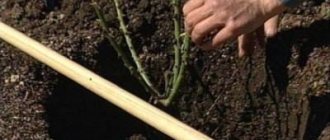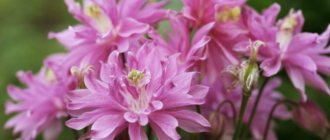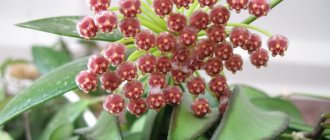History of the variety's creation
This rose variety was bred by breeders from Germany back in 1964. And almost immediately after its breeding, flower growers paid attention to this variety, unusual in flower color.
Subsequently, breeders continued to work on improving this rose, and in 1974 they introduced a new variety of Blue Moon - climbing.
Photo of rose Blue Moon
Main characteristics and description
Experts have bred two types of Blue Moon rose:
- Hybrid tea subspecies, bred first. This shrub can grow up to 1 m in height. The buds are large; after full bloom, the flower of the hybrid tea rose Blue Moon can be up to 12 cm in diameter. The color of the petals can be lavender, blue, or lilac.
Photo of hybrid tea rose Blue Moon
- Climbing, bred on the basis of the hybrid tea variety Blue Moon. The length of the lashes can be 3.5-4 m. The color of the petals of the buds is silver-lilac. Large flowers of the climbing rose Blue Moon can reach 10 cm in circumference.
Photo of climbing rose Blue Moon
The width of the shrub can reach 0.6 m. The shoots are erect, strong, with medium foliage. The foliage is medium in size, slightly elongated, with sharp tips, edges with sparse serrations. The outer side of the leaf blades is slightly wrinkled, with a characteristic shine, the color is dark emerald.
Both subspecies of Blue Moon are repeat blooming roses.
A characteristic feature of both varieties is the change in color of the petals of the buds depending on the place of cultivation. When this flowering shrub is grown in partial shade or shade, the color of the petals becomes pinkish. If there is enough sun in the area where this rose grows, then the color of the petals becomes purple or blue.
Hybrid tea rose Blue Moon (rose blue moon) review - video
The shape of the blooming buds is goblet-shaped, the flowers are semi-double, each of them can have about 25 petals.
On a note!
The aroma of the blooming buds of the Blue Moon rose is rich, quite strong, with notes of rose oil and fruit.
The buds bloom slowly - about 10-12 days, and they can also stand in water for a long time after cutting.
. These qualities, as well as the original color of the petals, make the Blue Moon variety attractive to florists - they make beautiful bouquets, including Blue Moon roses, and also create colorful holiday compositions.
Flowering for both the hybrid tea and climbing roses Blue Moon begins in June, in mid-late July all the buds that appear fade, and after 10-15 days new flowers appear on the bushes. Flowering continues until the second or third decade of September.
It should be noted that Blue Moon rose bushes are not very frost-resistant, so in regions with severe snowless winters, special care must be taken to cover this bush before the onset of cold weather.
Climbing rose Blue Moon (rosa) review - video
Conditions comfortable for the Blue River
It is quite easy to choose comfortable lighting for Blue River. This is a light-loving rose that feels better in sunny locations. But even in partial shade it will bloom no less colorfully (however, there it becomes more vulnerable to diseases and pests, and it is still better to provide good lighting for the Blue River).
Rose "Blue River" Roland zh
Try to protect this rose from cold winds, because it is not the most resistant and hardy plant that may feel uncomfortable in windy areas. But this requirement applies only to cold winds, and not to drafts. A prerequisite for success in growing Blue River is proper ventilation of the foliage and free, active air circulation. This rose does not respond well to wetness and precipitation. Wet leaves should dry out very quickly, and for this the rose itself must be placed in well-ventilated, warm areas.
Pay attention to the choice of soil. It should be rich in organic matter and nutrients
It is imperative to ensure “Blue River” and water permeability and a loose texture. Even on ideal soil, a drainage layer is still laid.
Use of the Blue Moon rose variety by landscape designers
Blue Moon rose varieties are often used in landscape design as base plants.
Rose bushes of this variety look great in single plantings against the backdrop of green lawns, as well as next to coniferous shrubs:
- thuja;
- cypress;
- blue spruce
Photo of Blue Moon rose in landscape design
This flowering shrub also looks great with clematis or climbing vines.
The following plants can be planted in front of Blue Moon rose bushes:
- lavender;
- fennel;
- issol.
It is also possible to combine this tall shrub with low-growing flowering plants and bushes.
Diseases and pests
This type of rose has average resistance to the main diseases of this perennial crop.
The most common diseases of the Blue Moon shrub are:
- peronosporosis, the most effective fungicidal drug in the fight against downy mildew on roses is Fundazol;
- gray rot, which can be destroyed with Fundazol or Euparen;
- When rust symptoms appear, Blue Moon rose bushes should be treated with Fitosporin.
The following insect pests also attack the bushes of this rose:
- roseate aphid, which should be combated with the following drugs: Iskra, Alatar;
- pennitsa, any insecticidal preparations can be used to destroy it;
- leaf roller, chlorophos is usually used against this pest;
- sawflies are destroyed with the help of Actellik;
- Spider mites on roses are usually dealt with using Alatar or Aktara.
Positive qualities of the Blue Moon rose
The main advantages of this rose variety include:
- unusual original color of the petals;
- the buds have a beautiful goblet shape, the blooming flowers are large;
- Blue Moon rose has a strong pleasant aroma;
- This rose variety is a repeat bloomer.
Experts include the following disadvantages of the variety:
- Blue Moon rose has low winter hardiness;
- the bushes of this “queen of flowers” are characterized by low resistance to disease; in order for the color of the flowers to be distinguished by an unusual blue color, the bushes of this rose must be grown in areas well illuminated by the sun's rays;
- Due to its low resistance to frost, this variety requires careful shelter before the onset of winter.
How to grow?
The liana can be grown in different ways, which determine the time at which the first flowers are produced and its resistance to the weather conditions of the region.
Methods:
- Planting in containers. If it is possible to annually move a container with a volume of at least 40 liters, “Blue Moon” in the form of a seedling is planted in such a container. For the winter it is put away in a dark, heated room. All fertilizing is canceled and watering is reduced to a minimum. In the spring, before “going out,” active watering begins (up to 3 times a week); after the threat of frost has passed, the wisteria can be taken outside. The disadvantage of this method is the serious weight of the vine.
- Planting in open ground. The planting material must be a young seedling. It is purchased from companies involved in breeding such plants, or grown independently from seeds. Seeds germinate only in the presence of high temperature and humidity. Direct sunlight has a detrimental effect on seedlings. Such a seedling will bloom no earlier than in 5 years, but at the same time it will be resistant to all weather troubles.
Important! For growing from seeds, it is recommended to take those obtained from plants growing in the region for further cultivation of Blue Moon.
Rules for growing Blue Moon roses
You should begin preparing for planting this rose variety by selecting healthy seedlings.
They must have the following qualities:
the root system is sufficiently branched, the roots themselves are strong and elastic without visible signs of damage or disease, at least three shoots on the above-ground part, without signs of the beginning of sap flow (the buds should not be swollen), the root collar is green in color.
Climbing roses from a box Planting in pots - video
Rose planting time
It is best to plant Blue Moon rose in late April - early May, depending on the climatic conditions of the growing region. The soil on the site should be warmed up to 15 degrees Celsius, because a seedling of this rose may not take root in cold soil.
It should also be taken into account that the plant may freeze if the temperature remains below freezing at night, in which case you should wait to plant the rose.
Site selection
In order for this rose variety to feel comfortable, you need to choose the right site for planting it. The best location is one that receives direct sunlight all day except during the midday hours. But the Blue Moon rose grows well in light partial shade.
Important!
The planting site should be protected from strong winds and drafts, and moisture should not stagnate in the soil.
Preparing the landing site
The selected area is cleared of remnants of vegetation and dug well so that the soil becomes loose. Then holes are dug in such a way that the roots of the Blue Moon rose seedlings fit freely into them.
Then prepare a nutrient substrate, taking equal parts of garden soil, river sand, high-moor peat and humus.
100 g of superphosphate and the same amount of wood ash are added to the resulting soil mixture. The mixture is thoroughly mixed and the planting holes are filled approximately halfway with it.
Planting a Blue Moon rose
Before planting, Blue Moon seedlings are placed in containers with water so that their roots are completely saturated with moisture. The roots of the plant are inspected, removing damaged or rotten areas. All cuts are sprinkled with crushed charcoal. The stems are also shortened.
A layer of drainage is placed at the bottom of the holes, then a layer of nutrient substrate from which a mound is formed. A plant is placed on its top, and its roots are carefully straightened along the slopes. After this, the hole is filled with soil and compacted.
Important!
The root collar should be several centimeters below the soil surface.
Then watering is carried out, adding 5 liters of water to each seedling. The tree trunk circle is mulched with mowed grass after watering.
Flower propagation
When is it produced?
The division of the bush is carried out in the spring, before the formation of buds. Cuttings are carried out in the summer, after the buds begin to appear. Layering is done at any time during the growing season, after flowering has ended.
Detailed description
To divide a bush, it is dug out of the soil and carefully cut into two parts. Each part is planted in a separate planting hole.
Cuttings. Take a green dense shoot. It must have at least three buds. Trim, the length of the cutting should be about 12 cm. The lower cut must be treated with a substance to accelerate the appearance of the root. Plant the cuttings in the soil and cover the top with a jar, bottle or film. Water regularly.
Important! Layerings are made from climbing roses. Make a ditch near the bush and place the root shoot in it. Sprinkle soil on top. Water regularly.
climbing rose
Further care for Blue Moon roses
In the future, when caring for this rose, you should follow the watering regime, fertilize and trim these shrubs in a timely manner.
Irrigation regime
These rose bushes love moist soil, only then they grow intensively and bloom profusely.
Therefore, water the Blue Moon rose regularly, and you need to make sure that the top layer of soil is constantly moist. However, there should not be stagnation of moisture in the soil.
Watering is carried out in the evening, while moisture is applied strictly at the root and care is taken that drops of water do not fall on the foliage and shoots. Water for irrigation should be settled and warm.
Therefore, in hot, dry weather, the Blue Moon rose is watered more often, and in rainy times, the number of waterings is sharply reduced so that moisture does not stagnate in the soil - this can lead to rotting of the root system of the bush.
Beautiful varieties of roses:
Rose Ballerina Rose Midsummer Rose Rhapsody in Blue
Feeding rose bushes
After watering and rain, the soil should be loosened and then mulched so that the soil does not overheat and retains moisture longer.
For active growth and abundant flowering, this rose variety should be fed regularly.
In total, this shrub should be fertilized at least 5 times during the summer season. The first feeding is carried out in the spring, after the buds begin to open on the bushes.
Rose Blue Moon accepts organic and mineral fertilizers equally well, so such fertilizers are applied constantly, but they need to be alternated.
Landing
To plant a perennial liana, you will need 2 seedlings, the root system of which must be of a closed type.
This factor affects the adaptation of the plant, making it less painful. Wisteria can be cultivated in any soil. It is best to plant in a place with slightly alkaline soil. It is also recommended to add humus to the soil and drain it well. Strongly acidic peat soil is not suitable for growing vines. Before planting wisteria, dig a hole 25 centimeters deep and fill it with organic fertilizer. Humus is best. You can prepare a mixture of thawed leaves, river sand and clay soil. The plant is planted using the transshipment method, without deepening the root collar area.
The seating area should be well lit. Wisteria flowers need sunlight for normal development. The plant must also be well protected during the cold season. Therefore, having a wall close to the seat will help protect against drafts and wind. Due to the characteristics of wisteria, it is recommended to plant it in a calm and warm place. The shoots of the plant weave strongly, for this reason it needs supports that are installed near the vines.











